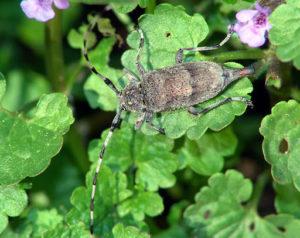Gray barbel beetle: a useful owner of a long mustache
In the forest, you can often meet a gray long-whiskered barbel. Acanthocinus aedilis is also called Lumberjack. Segmented long whiskers make them original and unique among other insects.
Content
Gray long mustachioed: photo
Description of the gray long-whiskered
Name: Mustache gray long mustache
Latin: Acanthocinus aedilisClass: Insects - Insecta
Squad: Coleoptera - Coleoptera
Family: Barbels - Cerambycidae
 | Habitats: | coniferous and deciduous plantings |
 | Dangerous for: | destroys diseased trees and deadwood |
 | Means of destruction: | does not need to be destroyed |
The color of the insect is interspersed with gray-brown-black dots. Small spots create a pattern that looks like tree bark. Thanks to this, they are perfectly camouflaged. The coloration of the hard elytra is light gray with a pair of stripes. Belly oval. It has a gray color. The color of the limbs is brownish-gray. Faceted eyes.
The main difference from other beetles are 4 spots on the pronotum. The spots are orange-red in color. The size varies between 1,2 - 2 cm. Males are smaller than females. In males, the mustache can exceed the length of the body by 5 times. The females have a tapering, flat, elongated rear part - the ovipositor.
Life cycle of the gray long-horned beetle
Activity is related to temperature. With the onset of warm weather in spring, the beetles begin to fly. This period lasts until a cold snap in September.
Good fertility does not allow the total number to decrease.
Diet and habitat
Insects do not affect living wood. Dead bark and fallen needles are a favorite food. If there are few coniferous trees in the forest, then insects can consume deciduous species.
Insects live in Europe, Russia, Kazakhstan, China, the Caucasus. Beetles prefer coniferous forests and pine forests. Also, beetles can settle in a mixed forest. The exception is the Mediterranean coast.
Temperate and subtropical climates are best suited. Favorite habitats are fallen trunks, stumps, rotting wood, windbreak.
Conclusion
The long-whiskered gray beetle does not damage forests. Insects feed on dying trees and deadwood. The important ecological role of beetles in nature makes it a welcome guest in various types of plantations.
Previous